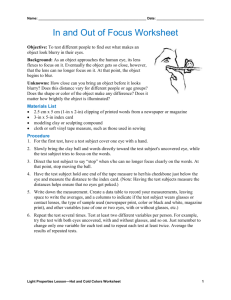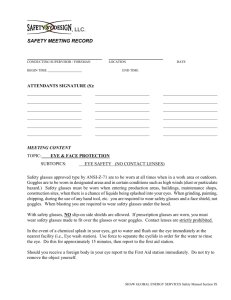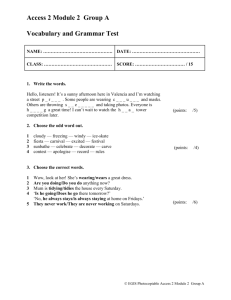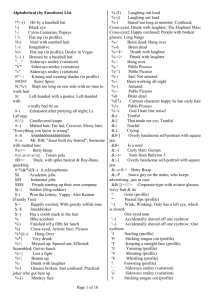Teachers` Notes
advertisement
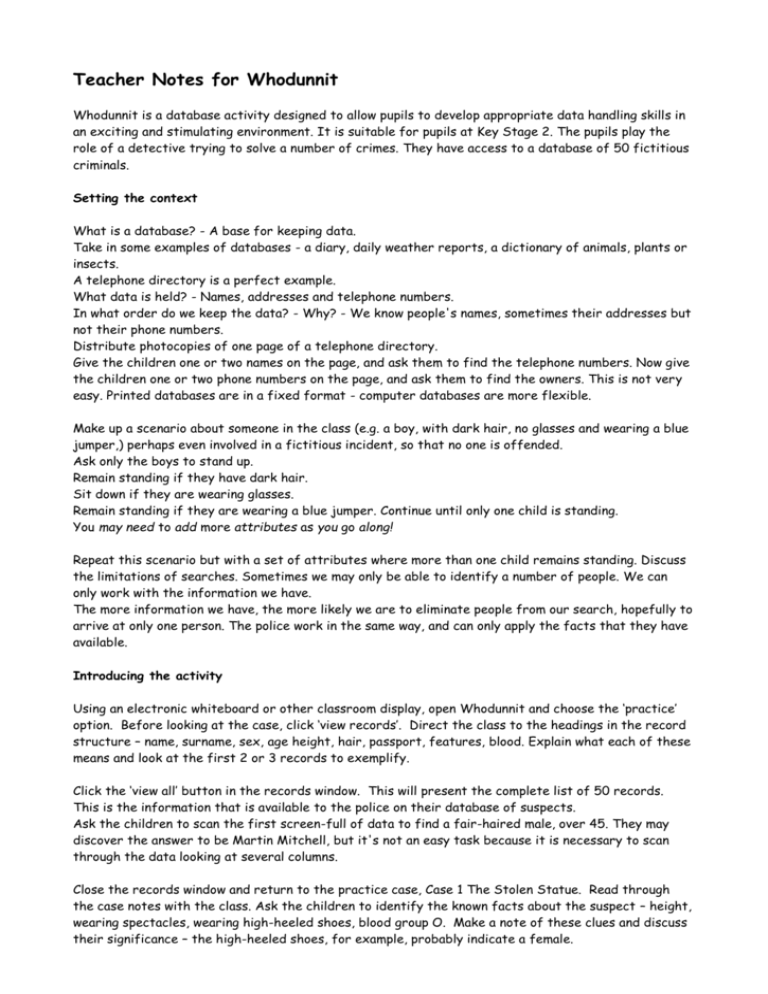
Teacher Notes for Whodunnit Whodunnit is a database activity designed to allow pupils to develop appropriate data handling skills in an exciting and stimulating environment. It is suitable for pupils at Key Stage 2. The pupils play the role of a detective trying to solve a number of crimes. They have access to a database of 50 fictitious criminals. Setting the context What is a database? - A base for keeping data. Take in some examples of databases - a diary, daily weather reports, a dictionary of animals, plants or insects. A telephone directory is a perfect example. What data is held? - Names, addresses and telephone numbers. In what order do we keep the data? - Why? - We know people's names, sometimes their addresses but not their phone numbers. Distribute photocopies of one page of a telephone directory. Give the children one or two names on the page, and ask them to find the telephone numbers. Now give the children one or two phone numbers on the page, and ask them to find the owners. This is not very easy. Printed databases are in a fixed format - computer databases are more flexible. Make up a scenario about someone in the class (e.g. a boy, with dark hair, no glasses and wearing a blue jumper,) perhaps even involved in a fictitious incident, so that no one is offended. Ask only the boys to stand up. Remain standing if they have dark hair. Sit down if they are wearing glasses. Remain standing if they are wearing a blue jumper. Continue until only one child is standing. You may need to add more attributes as you go along! Repeat this scenario but with a set of attributes where more than one child remains standing. Discuss the limitations of searches. Sometimes we may only be able to identify a number of people. We can only work with the information we have. The more information we have, the more likely we are to eliminate people from our search, hopefully to arrive at only one person. The police work in the same way, and can only apply the facts that they have available. Introducing the activity Using an electronic whiteboard or other classroom display, open Whodunnit and choose the ‘practice’ option. Before looking at the case, click ‘view records’. Direct the class to the headings in the record structure – name, surname, sex, age height, hair, passport, features, blood. Explain what each of these means and look at the first 2 or 3 records to exemplify. Click the ‘view all’ button in the records window. This will present the complete list of 50 records. This is the information that is available to the police on their database of suspects. Ask the children to scan the first screen-full of data to find a fair-haired male, over 45. They may discover the answer to be Martin Mitchell, but it's not an easy task because it is necessary to scan through the data looking at several columns. Close the records window and return to the practice case, Case 1 The Stolen Statue. Read through the case notes with the class. Ask the children to identify the known facts about the suspect – height, wearing spectacles, wearing high-heeled shoes, blood group O. Make a note of these clues and discuss their significance – the high-heeled shoes, for example, probably indicate a female. Display the first screen of the full list of 50 records again and ask the children to scan through and identify the suspect. Again, scanning all the data is difficult and mistakes may be made. Explain that using a computerised database, we may display the information in any way we choose and we can also narrow down searches very easily. Refer back to the case and use the first of the search boxes to look for: <1.7 in Height (explain the use of < if children are unfamiliar with this). Click the ‘search’ button. This produces a long list of suspects. More of the clues must be used to refine the search further. Add: female in Sex This has narrowed the field down to 5 suspects. Add: glasses in Features Now there are only 2 suspects. Explain the importance of using the correct words (correctly spelt) for the database. Sherlock Holmes uses the word ‘spectacles’ in the case notes although the database uses the word ‘glasses’. Explain that it may be necessary to check back to the full data list to find out what words to use, as the search will only work with the correct word. Demonstrate this using the word ‘spectacles’ instead of glasses. The result will be ‘no records found’. Finally add: O in Blood A culprit is found, Emma Hunter, record 2. Confirm that she does indeed fit all the clues by clicking ‘view records’ and going to record 2. There she is – a female of height 1.67m (shorter than Lord Duncan), who wears glasses and has blood group O. Close the ‘records’ window and with just the name Emma Hunter showing in the suspects window click ‘culprit’. This produces a confirmation that the correct culprit has been found. Paired or group work Allow the children to work in pairs or small groups to investigate 5 or 10 cases (depending on the time available). Cases are chosen at random – some require more deductive reasoning than others. If the pupils have enjoyed this activity then they could try making up their own database and scenarios. Common themes are pirates, cowboys and teachers. Alternatively similar database search activities are available elsewhere on this website. Acknowledgements Whodunnit was first published by the North Eastern Education and Library Board from an original idea by John Doherty. We are grateful to NEELB for permission to update and use the resource.

